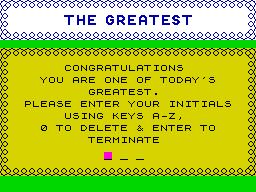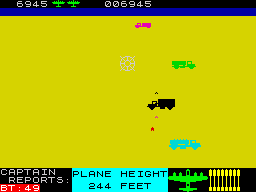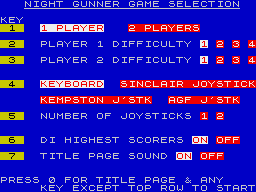Retro Replay Review
Gameplay
Night Gunner offers a distinctive blend of shoot ’em up action and rudimentary flight simulation. From the moment you strap into the cockpit of the Lancaster bomber, it’s clear that precision shooting and split-second reactions are the heart of the experience. Rather than piloting the plane’s full flight envelope, you’re stationed at the gun turret, tasked with fending off swarms of enemy fighters and neutralizing strategic targets below.
(HEY YOU!! We hope you enjoy! We try not to run ads. So basically, this is a very expensive hobby running this site. Please consider joining us for updates, forums, and more. Network w/ us to make some cash or friends while retro gaming, and you can win some free retro games for posting. Okay, carry on 👍)
The game is neatly divided into shooting and bombing phases. In the shooting segments, you swivel your turret to engage balloons, agile enemy fighters, and the occasional heavy bomber. Each successful kill brings you one step closer to mission victory, but sustained damage to your engines or turret can quickly turn the tables. If three engines are knocked out, the bomber loses lift and your run ends abruptly in a fiery crash.
Bombing runs add a fresh layer of challenge. You alternate between high-altitude and low-altitude sorties, each with a finite load of ordnance. High-level bombing demands accurate timing and sharp reflexes to dodge incoming flak, while low-level attacks pit you against concentrated ground fire and the constant threat of colliding with terrain. Mastering both styles is key to progressing through the tougher missions.
What sets Night Gunner apart is its straightforward yet unforgiving damage model. A crippled gun turret drags your aiming reticle across the screen with noticeable lag, simulating a jammed mechanism, and complete turret loss leaves you defenseless. Engine hits not only impact your survivability but also subtly alter your aiming stability, forcing you to prioritize defensive maneuvers once you’re under heavy fire.
Graphics
For a late-80s title, Night Gunner’s graphics hold up remarkably well. The cockpit interior is rendered with crisp lines and clear instrumentation, giving you immediate visual feedback on your remaining engines and turret health. Enemy sprites—ranging from nimble fighters to lumbering bombers—are distinct and animated with enough frames to convey smooth motion.
Ground textures and cloud layers are kept fairly minimal to maintain frame rate, but the rolling landscapes below provide just enough variety to keep bombing runs interesting. Explosions are vividly depicted, with bright flashes and expanding shockwaves that punctuate each successful hit. Balloons drift overhead with jaunty colors, making them easy but satisfying targets during the early stages of a mission.
While there’s little in the way of parallax scrolling or dynamic lighting, the game’s art style captures the gritty atmosphere of World War II aviation. The contrast between the dark cockpit frame and the bright sky outside makes it easy to track fast-moving enemies, and the occasional damage overlay (cracked glass, smoke) adds a layer of immersion when your plane takes a beating.
Performance is solid even on period-correct hardware, with no noticeable slowdown during the most intense firefights. Sound effects—gunfire bursts, rumbling engines, and explosion FX—complement the visuals nicely, though they follow a functional approach rather than an ambient one. Overall, the graphics serve their purpose effectively, keeping the focus on fast-paced arcade action.
Story
Night Gunner doesn’t invest heavily in narrative depth; it opts instead for a straightforward framing device rooted in World War II aerial combat. You’re cast as the last line of defense in a Lancaster bomber’s gun turret, called upon to repel waves of threats over enemy territory. Brief text intros set the scene for each mission, but once the engines roar to life, it’s all about the action.
There are no named characters, cutscenes, or branching plotlines—just mission after mission of high-adrenaline combat. This minimalist approach ensures you stay focused on gameplay, but it does leave those craving dramatic tension or character development wanting more. If you’re looking for the human side of wartime drama, you won’t find it here.
That said, the setting itself is evocative. The tension of flying deep into hostile skies, combined with the knowledge that every hit could spell disaster for your crew, creates a palpable sense of urgency. Mission briefings hint at larger strategic goals—nun raids, supply line disruptions—but the emphasis remains firmly on aerial gunnery rather than storytelling flourish.
Overall Experience
Night Gunner is best described as a focused arcade shooter wearing a flight-sim hat. Its simple mission structure, clear objectives, and punishing damage mechanics deliver a satisfying challenge for players who enjoy twitch-based gameplay. The limited ammo, engine health, and turret status systems add layers of resource management, ensuring that each decision to engage or evade carries weight.
Difficulty ramps up rapidly, making early missions feel like warm-ups before your reflexes and strategy are truly tested. The absence of quick-save options on vintage systems heightens the stakes, turning each sortie into a make-or-break endeavor. For modern players accustomed to generous checkpoints, the game’s old-school toughness may feel relentless—but also rewarding when you clear a level unscathed.
Replay value is solid, thanks to the desire to improve accuracy, conserve ammo, and push further into the campaign. High-score chasing adds another layer of motivation, particularly for fans of classic arcade shooters. If your tastes lean toward narrative-driven simulations or immersive flight models, you might find Night Gunner’s arcade leanings a bit limiting. However, for those who relish straightforward, action-packed aerial combat with a WWII backdrop, it represents a hidden gem from Digital Integration’s catalog.
In summary, Night Gunner marries the thrill of firefights with just enough simulation flair to stand out from pure shoot ’em ups. Its fast pace, clear visuals, and unapologetic difficulty make it an engaging pick for retro gaming enthusiasts and anyone seeking a challenging aerial combat experience.
 Retro Replay Retro Replay gaming reviews, news, emulation, geek stuff and more!
Retro Replay Retro Replay gaming reviews, news, emulation, geek stuff and more!









Reviews
There are no reviews yet.